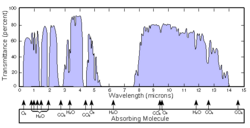Transmittance


Electromagnetic radiation can be affected in several ways by the medium in which it propagates. It can be scattered, absorbed, and reflected and refracted at discontinuities in the medium. This page is an overview of the last 3. The transmittance of a material and any surfaces is its effectiveness in transmitting radiant energy; the fraction of the initial (incident) radiation which propagates to a location of interest (often an observation location). This may be described by the transmission coefficient.
Surface Transmittance
Hemispherical transmittance
Hemispherical transmittance of a surface, denoted T, is defined as
where
- Φet is the radiant flux transmitted by that surface into the hemisphere on the opposite side from the incident radiation;
- Φei is the radiant flux received by that surface.
Hemispheric transmittance may be calculated as an integral over the directional transmittance described below.
Spectral hemispherical transmittance
Spectral hemispherical transmittance in frequency and spectral hemispherical transmittance in wavelength of a surface, denoted Tν and Tλ respectively, are defined as
where
- Φe,νt is the spectral radiant flux in frequency transmitted by that surface into the hemisphere on the opposite side from the incident radiation;
- Φe,νi is the spectral radiant flux in frequency received by that surface;
- Φe,λt is the spectral radiant flux in wavelength transmitted by that surface into the hemisphere on the opposite side from the incident radiation;
- Φe,λi is the spectral radiant flux in wavelength received by that surface.
Directional transmittance
Directional transmittance of a surface, denoted TΩ, is defined as
where
- Le,Ωt is the radiance transmitted by that surface into the solid angle Ω;
- Le,Ωi is the radiance received by that surface.
Spectral directional transmittance
Spectral directional transmittance in frequency and spectral directional transmittance in wavelength of a surface, denoted Tν,Ω and Tλ,Ω respectively, are defined as
where
- Le,Ω,νt is the spectral radiance in frequency transmitted by that surface;
- Le,Ω,νi is the spectral radiance received by that surface;
- Le,Ω,λt is the spectral radiance in wavelength transmitted by that surface;
- Le,Ω,λi is the spectral radiance in wavelength received by that surface.
Luminous transmittance
In the field of photometry (optics), the luminous transmittance of a filter is a measure of the amount of luminous flux or intensity transmitted by an optical filter. It is generally defined in terms of a standard illuminant (e.g. Illuminant A, Iluminant C, or Illuminant E). The luminous transmittance with respect to the standard illuminant is defined as:
where:
- is the spectral radiant flux or intensity of the standard illuminant (unspecified magnitude).
- is the spectral transmittance of the filter
- is the luminous efficiency function
The luminous transmittance is independent of the magnitude of the flux or intensity of the standard illuminant used to measure it, and is a dimensionless quantity.
Internal Transmittance
Optical Depth
By definition, internal transmittance is related to optical depth and to absorbance as
where
- τ is the optical depth;
- A is the absorbance.
Beer–Lambert law
The Beer–Lambert law states that, for N attenuating species in the material sample,
where
- σi is the attenuation cross section of the attenuating species i in the material sample;
- ni is the number density of the attenuating species i in the material sample;
- εi is the molar attenuation coefficient of the attenuating species i in the material sample;
- ci is the amount concentration of the attenuating species i in the material sample;
- ℓ is the path length of the beam of light through the material sample.
Attenuation cross section and molar attenuation coefficient are related by
and number density and amount concentration by
where NA is the Avogadro constant.
In case of uniform attenuation, these relations become
Cases of non-uniform attenuation occur in atmospheric science applications and radiation shielding theory for instance.
















